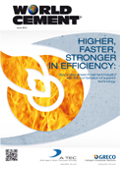Editorial comment
At last month’s IEEE-IAS/PCA Conference (to be reviewed in the July issue), it came to my attention that the cement industry could sometimes be accused of being a little introspective. We are so focused on improving the process, cutting costs, meeting regulations, and keeping the plant running that we may lose sight of what happens beyond the boundaries of the plant. Where does the product end up?
Register for free »
Get started now for absolutely FREE, no credit card required.
We talk about cement demand in general terms. It is pluses and minuses on a spreadsheet, with infrastructure investment, weather conditions and politics held to account for the red and black, but what some of the papers at the conference reminded me is that we have to actively market cement and concrete in order to make sure it is the material of choice for construction projects. In terms of road building, for example, our industry faces strong competition from asphalt, which is more widely used for this purpose. This is despite evidence showing that concrete is the better choice in the long-term with regards to both cost-efficiency and longevity. I have seen advertising campaigns for bagged cement and they show a lot of creativity, but companies are concerned with promoting their brand rather than cement as a building material. This is understandable, but it’s not enough. These adverts are, to use the expression, preaching to the choir. Those customers who have got to the point of choosing between cement suppliers have already chosen cement; the people that need to be targeted are those who have not yet made the choice, or who have previously decided against using concrete.
When making the argument for concrete, it is worth looking at the Portland Cement Association (PCA) website, www.think-harder.org. Think Harder is an initiative by the PCA that highlights the benefits of concrete as compared to other building materials, in terms of longevity, cost and energy efficiency. Included on the site is the MIT Concrete Sustainability Hub – a portal to further information from the Massachusetts Institute of Technology’s research centre founded in October 2009 in collaboration with the PCA and the Ready-Mixed Concrete Research and Education Foundation. The Hub’s research is currently centred around three main points: concrete materials science, building technology, and the econometrics of sustainable development. Dr Franz-Josef Ulm, one of the programme’s Principal Investigators, gave two presentations at the IEEE-IAS/PCA Conference, which, together with Dr Cesar Constantino’s workshop on ‘Industry Approach to Stakeholder Involvement’, inspired this column. I came out of those papers agreeing with Dr Constantino that the cement industry must think beyond the fence. First, we need to educate ourselves to make sure we are fully armed with the facts regarding the use of concrete for sustainable construction, and then we need to educate stakeholders to make sure that the message is understood. Think Harder is a good starting point to make sure you have all the information you need in your arsenal.
Talking of sustainability, this issue includes an article that attempts to distinguish between acting sustainably and greenwashing (page 63). I’d be interested to hear your thoughts on this topic, so please do join our group on LinkedIn and get involved in our discussions. LinkedIn is also a good place to let us know what you are interested in reading about and to ask any questions you might want to put to the forum. World Cement is also active on Twitter, Facebook and now also Google+, as well as, of course, at www.worldcement.com where we’re still keeping you updated with all the latest news. Our blog is also going strong, and has the facility to post comments, so have a read and let us know what you think.


